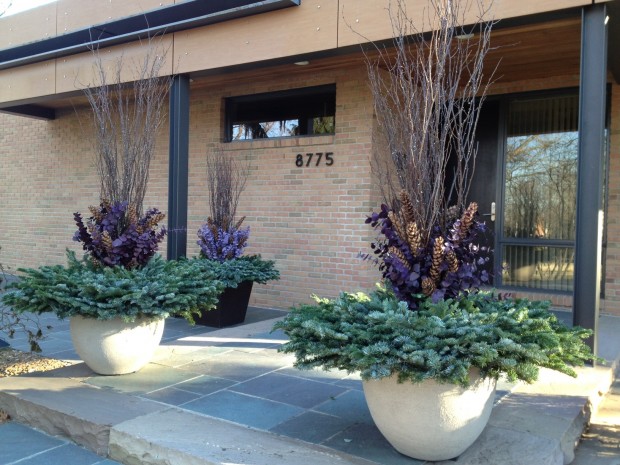
purple and lavender
 Dressing a fountain for winter
Dressing a fountain for winter
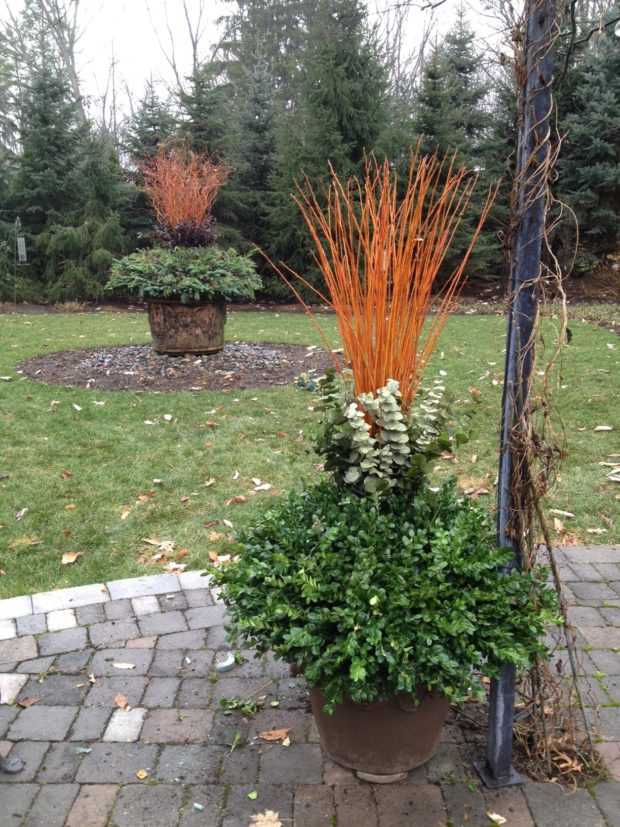 Francesca del Re terra cotta pot ready for winter
Francesca del Re terra cotta pot ready for winter
 blanket of noble and silver fir
blanket of noble and silver fir
 curly copper willow and oregonia
curly copper willow and oregonia
 red bud pussy willow, mixed greens, fan willow, and purple eucalyptus
red bud pussy willow, mixed greens, fan willow, and purple eucalyptus
Deborah Silver is an accomplished and experienced landscape and garden designer whose firm first opened its doors in 1986.

purple and lavender
 Dressing a fountain for winter
Dressing a fountain for winter
 Francesca del Re terra cotta pot ready for winter
Francesca del Re terra cotta pot ready for winter
 blanket of noble and silver fir
blanket of noble and silver fir
 curly copper willow and oregonia
curly copper willow and oregonia
 red bud pussy willow, mixed greens, fan willow, and purple eucalyptus
red bud pussy willow, mixed greens, fan willow, and purple eucalyptus
The shop landscape is very simple. A rectangle of boxwood set in a generous plane of decomposed granite, a pair of Techny arborvitae bookends, and a pair of lindens is about all there is. These plants, almost 20 years old, occupy a modest percentage of the overall space. This means there is room for a temporary, ephemeral, and seasonal garden expression. Gardening in a zone which features four distinct seasons is a challenge and an opportunity I would never want to do without. The chance to start fresh given the change of the season-love that. The holiday/winter garden is no different.
The inspiration is almost always driven by a natural material that catches my eye. This year, the curly copper willow branches are incredibly beautiful. The color is rich and saturated. The stems are fat and juicy-there is no hint of stress from the drought they endured all summer. They have a distinctly fresh fragrance. Each stout stem was topped with a cloud of delicate branches-breathtaking. I ordered extra, so I would have enough to do the garden in front of the shop.
What would I do with them? Fresh willow is incredibly flexible. One could make baskets, fencing, wreaths-just about anything the eye could imagine, and the hand construct. But I wanted a structure that would permit those thousands of tiny branches to make their own statement. I use these steel forms at home to give my asparagus some support-I knew they would be perfect. Attaching the thick stems, one stem at a time to this form, would provide stability without interfering with the natural form and inclination of the branchlets.
Zip tying each branch was time consuming, and not so easy. Each stem needed a friendly neighbor. My landscape crew does a superb job of all of my landscape installations-their seasonal winter work is no exception. They are not only incredibly talented and willing, they have an understanding of natural forms that comes only with many years of exposure to plants. They never force anything to be. They let the material dictate the construction, and the overall shape. They use whatever they need to make the overall shape complete-even if that means I need to order more.
The douglas fir boughs have been stuffed into dry floral foam, some 6 inches thick. The bottom 3 inches are wedged into the rim of the pot. The six inches above the rim are a home to all of the boughs that are set horizontally. A form this high off the rim of the pot needs reinforcing. 4 pieces of steel rebar are driven through the corners of the foam, and into the soil in the pots. Once the soil freezes around that steel, it will take gale force winds to dislodge the curly willow.
A cloud of copper willow and a low wide base of douglas fir- this year’s holiday/winter expression. The time it takes to construct what will go on in these pots all winter is time I don’t spend moping about the closing of the garden. Should everything come together, these pots will make a statement about what is good about the winter season. A customer in the shop yesterday lives in San Francisco. He tells me the climate and weather is the most consistent and unchanging of any city in the US. Though he misses the change of the seasons, he does not miss the gray skies. He is right. Michigan is one of the grayest and gloomiest of all of the states in the winter.
So a good part of our winter garden is about turning the lights on. The light garland draped over the empty window boxes is comprised of three different strands of three different types of lights. The weight of multiple light strings twisted around each other makes them drape gracefully-they are heavy. Inside each willow cloud is a spot light, wedged into the floral foam. A collar of dry limelight hydrangeas flowers conceals it from view. The spot light illuminates the willow from within. How I like this idea, and and how it looks. A light garland would around the base of the willow illuminates them from the outside. A pair of ball and cone topiary froms are wound solid with ordinary garden variety mini lights. Ordinary materials do not have to be used in an ordinary way.
Having turned the lights on, I have no idea what I will do with this next. Part of the joy of a winter garden is having the time to tinker with it. The spring and summer garden-I am always running to try to keep up. This and that always needs something. Though I have a lot of work yet to come helping clients with holiday and winter containers and decorating, there will be time to figure out what else this garden might need.

Early this morning, a first dusting of snow. As my winter is most assuredly on the way, I would rather like it than not.
Coppicing is a traditional method of producing long straight woody stems by cutting a tree or a shrub back to the ground. Many varieties of woody plants respond to this drastic treatment with vigorous growth-from the ground. Coppice wood was used to provide firewood in European countries where the number of trees were vastly outnumbered by a large population requiring fire for cooking and heat. Shrubby trees wre planted on the perimeters of farms; regular coppicing produced densely twiggy living fences.
The new shoots emerging from the stump of a tree grow long and straight. The juvenile growth is vigorous, and the color is vibrant. In England, the coppice wood from the sweet chestnut tree is still used to make fencing and fence poles for livestock and poultry. The sweet chestnut is coppicied on 12 to 18 year cycles, and then harvested to make fencing and gates. The poles come from coppice wood which is allowed to grow upwards of 30 years before cutting.
The fresh cut twigs which arrive at the shop in early November are grown by farmers who plant their shrubs in rows or blocks, like crops. Large fields are harvested in rotation, so every year there is a crop of long straight stems. Many of our twigs come from varieties of salix, or willow. Every gardener knows that the new or current year’s growth on a red twig dogwood shrub has the best color. Mature stems become woody, and the color dull. The new bark of coppice wood is lively. Newer cultivars of the redtwig dogwood have better and brighter color. The coppice wood of this redtwig dogwood cultivar is known for its especially brilliant color.
Once the leaves fall, those twigs which are ready are harvested, sorted by length, bundled and shipped. Most bunches are 10 stems, except for the curly willow. The winter color of curly willow stems is subtle, but no so its shape. The curving and curling stems provide lots of volume-these voluminous bunches are usually 5 stems. 5 stems of this gracefully airy and unpredictably curving willow can endow a winter container arrangement with lots of rhythm and movement.
Coppiced yellow twig dogwood is brilliantly yellow green. The twigs will be color fast the entire winter. Used in a winter container, it is not unusual for the stems to root, and leaf out in the spring. Though but a very few of the leaves are still clinging, the branches are vibrant at a time of year when most all else in the garden has gone dormant.
Flame willow is a striking coppery orange in color-quite unlike the bark of the trees and shrubs that grow in my garden. This warm cinnamon color is a standout in snowy and gray weather. This variety of willow is much more handsome in its twiggy state than it is as a green-leaved shrub.
Japanese fan willow was cultivated from a fasciated, or flattened natural stem. Many perennials and shrubs will exhibit this peculiar characteristic. Some azaleas that exhibit densely twiggy growth were propagated originally from fasciated stems. Fan willow is noted for its exotic shapes and forms. No two branches ever look the same.
Curly copper willow exhibits much the same habit of growth as the green curly willow. However the striking color means it will take fewer branches to make a statement in a winter container. Our coppice wood has arrived at just the right time. The cold temperatures outside will help keep them fresh, and the surface of the bark glossy. Thought the color will survive the winter perfectly intact, the warm weather in the spring will eventually dessicate and shrivel the stems.
But there is a place for dry stems in winter containers. Dead wood branches that have shed their bark can be beautiful in a winter arrangement. Bleached natural branches are dramatically pale in color, and are visible from a great distance.
The coppice wood-just one element of many that goes into a beautiful winter container arrangement.
 Were someone to ask me to name my most favorite winter pots ever, no doubt this pair would immediately come to mind. These varnished Belgian oak boxes put together with precisely spaced countersunk screws quietly remind me of a double breasted band uniform replete with brass buttons; dignified and all put together. The noble fir and douglas fir greens are generous and wide. The pale bleached willow sticks have a collar of natural stick stacks that have absorbed moisture from the air, and arched over-naturally. These pots have the most fabulously artless hairdos. Bottlebrush snowflakes hang here and there. Just enough structure meets weathering natural material. The good proportions of top to bottom please me.
Were someone to ask me to name my most favorite winter pots ever, no doubt this pair would immediately come to mind. These varnished Belgian oak boxes put together with precisely spaced countersunk screws quietly remind me of a double breasted band uniform replete with brass buttons; dignified and all put together. The noble fir and douglas fir greens are generous and wide. The pale bleached willow sticks have a collar of natural stick stacks that have absorbed moisture from the air, and arched over-naturally. These pots have the most fabulously artless hairdos. Bottlebrush snowflakes hang here and there. Just enough structure meets weathering natural material. The good proportions of top to bottom please me.
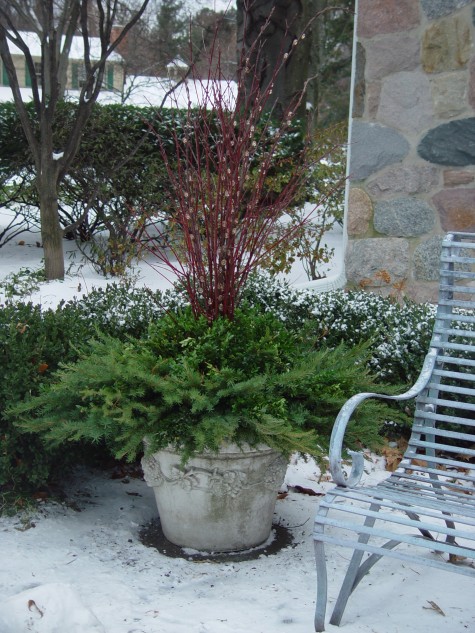 Though I personally have a mind to fend off the winter vigorously, I am lucky to have clients who do not mind the stillness of the winter season. They tell me: quiet, please. Represent me softly-naturally. Douglas fir and boxwood make such a great mix. A few stems of acrylic pussy willow adds just a little sparkle to the red twig.
Though I personally have a mind to fend off the winter vigorously, I am lucky to have clients who do not mind the stillness of the winter season. They tell me: quiet, please. Represent me softly-naturally. Douglas fir and boxwood make such a great mix. A few stems of acrylic pussy willow adds just a little sparkle to the red twig.
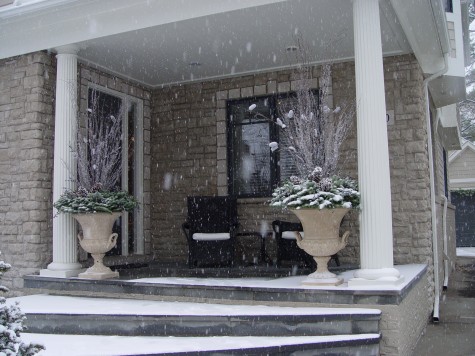 Intermittent snow in December dusts everything with white. This is beautiful winter weather-not the hit you over the head winter that is to come. The winter sculpture in this pair of pots demands nothing and expresses everything of a world gone silent.
Intermittent snow in December dusts everything with white. This is beautiful winter weather-not the hit you over the head winter that is to come. The winter sculpture in this pair of pots demands nothing and expresses everything of a world gone silent.
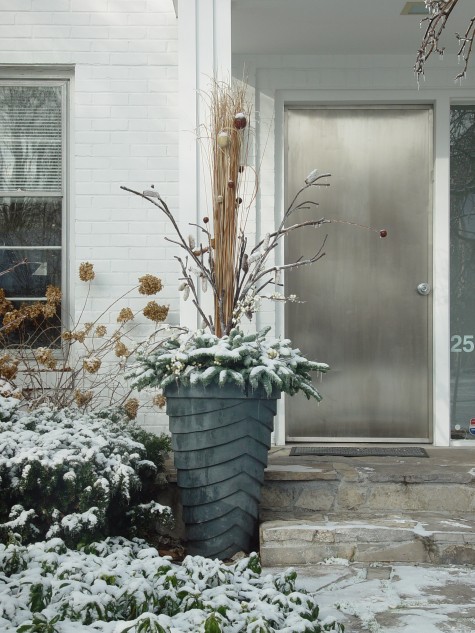 This client refurbished her front door in brushed stainless steel at my recommendation. This very contemporary Francesca del Re pot, and its winter dress, simply expresses the colors and shapes of her season. The color echoes what already exists in her hydrangeas and yews.
This client refurbished her front door in brushed stainless steel at my recommendation. This very contemporary Francesca del Re pot, and its winter dress, simply expresses the colors and shapes of her season. The color echoes what already exists in her hydrangeas and yews.
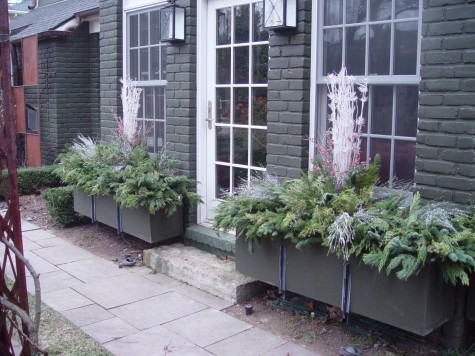
Big window boxes can speak softly, despite their size. Brushy, with pale accents-this is a choice. My recommendation? Decide in advance the feeling you wish to convey, and choose the materials accordingly. Accidents of nature are sometimes astonishingly good-other times, not so good. If I can spot what has gone wrong, chances are it can be fixed. Sometimes I have to see to know.
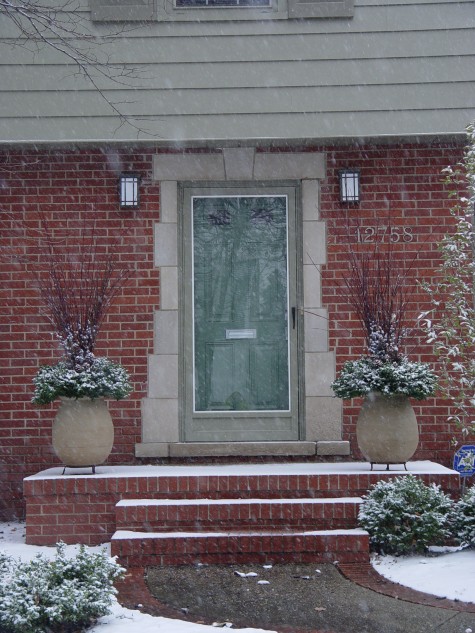 This pair of English stoneware pots from the Hode Pottery are frostproof-no need to bring them in. The simple trivet stands reveal the shape of the pots from top to bottom. A pot with a base larger than its opening benefits from a treatment like this. Twigs, cones and boxwood make for a dressy, not noisy display.
This pair of English stoneware pots from the Hode Pottery are frostproof-no need to bring them in. The simple trivet stands reveal the shape of the pots from top to bottom. A pot with a base larger than its opening benefits from a treatment like this. Twigs, cones and boxwood make for a dressy, not noisy display.
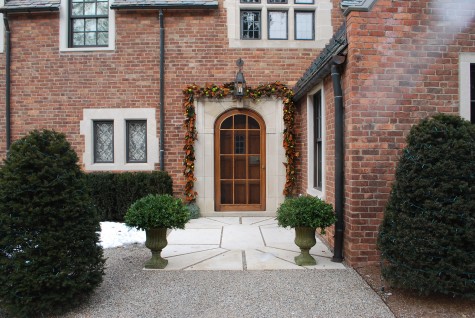
Growing boxwood in pots is not easy. They need attention all year round. They may need watering in a January thaw, and by March, regular water. The rootball of a well-grown boxwood is not much smaller than the top. They will only prosper in pots large enough to give their roots room to grow. Pots this size are much better filled with cut boxwood stuffed into a foam form. All the beauty of boxwood without so much responsibility.

I like everything about nature’s palette. The blues and greys of the stone, steel and snow. Twig, stem and leaf brown, with a dash of evergreen. What I see here is just enough celebration to take the chill off.
Deborah Silver is a landscape and garden designer whose firm, Deborah Silver and Co Inc, opened its doors in 1986. She opened Detroit Garden Works, a retail store devoted to fine and unusual garden ornament and specialty plants, in 1996. In 2004, she opened the Branch studio, a subsidiary of the landscape company which designs and manufactures garden ornament in a variety of media. Though her formal education is in English literature and biology, she worked as a fine artist in watercolor and pastel from 1972-1983. A job in a nursery, to help support herself as an artist in the early 80’s evolved into a career in landscape and garden design. Her landscape design and installation projects combine a thorough knowledge of horticulture with an artist’s eye for design. Her three companies provide a wide range of products and services to the serious gardener. She has been writing this journal style blog since April of 2009.
Copyright © 2024 · Deborah Silver & Co. · Detroit Garden Works